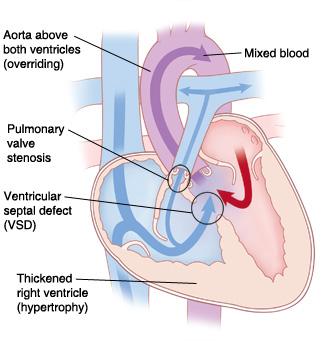Your Child's Tetralogy of Fallot Surgery
Your Child's Tetralogy of Fallot Surgery

A hole between the left and right ventricle
Blockage of blood flowing from the heart to the lungs
Aorta sits over the hole in the lower chambers
Thickened heart muscle in the lower right ventricle
How do I prepare my child for tetralogy of fallot surgery?
You’ll be told to keep your child from eating or drinking anything for a certain amount of time before surgery. Follow these instructions carefully.
What happens during tetralogy of fallot surgery?
Your child is given medication (sedative and anesthesia) to help him or her sleep and not feel pain during surgery. A breathing tube is placed in your child’s trachea (windpipe). Special equipment monitors your child’s heart rate, blood pressure, and oxygen levels. An incision is made in the chest through the sternum (breastbone) to access the heart. Your child is placed on a heart-lung bypass machine. This allows blood to continue flowing to the body so the heart can be operated on. The VSD is repaired with a patch. Tissue causing obstruction at or below the pulmonary valve is removed as needed. The pulmonary artery or the branch pulmonary arteries may be made larger with a patch. Then, your child is taken off the bypass machine and the chest is usually closed.
What happens after tetralogy of fallot surgery?
Your child is taken to a critical care unit to be cared for and monitored. You can stay with your child during much of this time. He or she may remain in the hospital for 5 to 10 days. When your child is ready to leave the hospital, you’ll be given instructions for home care.
When should I call my healthcare provider?
After heart surgery, call your child's healthcare provider right away if your child has any of the following:
Increased redness, draining, swelling, or bleeding at the incision site
Fever 100.4°F (38°C) or higher
Trouble feeding
Tiredness
Shortness of breath or trouble breathing
Cough that won’t go away
Nausea or vomiting that continues
Irregular heartbeat
Swelling or fluid buildup in the arms or legs
Passing out or dizziness
What are the long-term concerns?
Regular follow-up visits with the cardiologist are needed for the rest of your child’s life. Further pulmonary valve treatment — surgery or catheterization — may be needed in the future. Your child may also develop heart rhythm problems that may need to be treated.
After repair of TOF, most children can be active. The level and extent of physical activity will vary with each child. Check with the cardiologist about what activities are appropriate for your child.
Depending on the details of the surgery, your child may always need to take antibiotics before having any surgery or dental work. This is to prevent infection of the inside lining of the heart and valves. This infection is called bacterial endocarditis. Antibiotics should be taken as directed by the cardiologist.
Updated:
July 27, 2018
Sources:
Management and outcomes of tretraology of fallot, Up To Date
Reviewed By:
Ayden, Scott, MD,Bass, Pat F. III, MD, MPH,Image reviewed by StayWell medical illustration team.